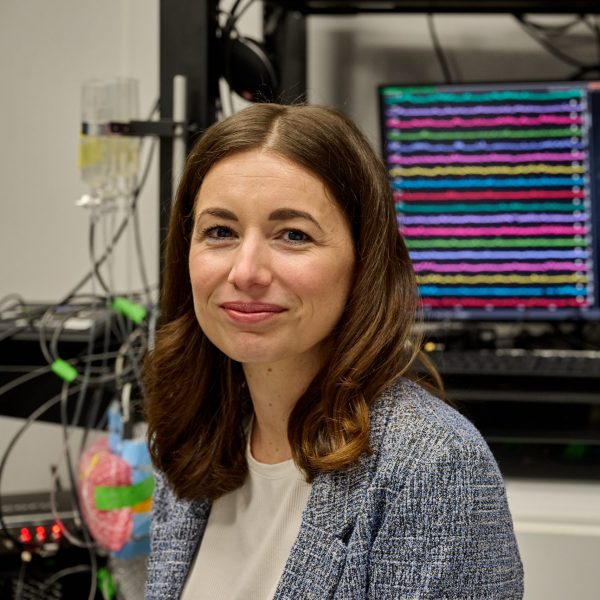
UConn Today: “Meet the Researcher: Natale Sciolino, CLAS“
Natale Sciolino was featured in UConn Today to introduce her and her work on cannabinoids and the Locus Coeruleus.
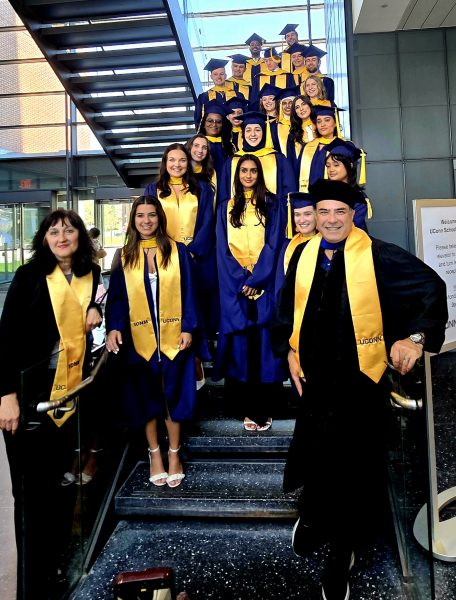
UConn PNB IONM reaches 1000 surgical cases
On April 7, 2025, the IONM program for the first time, exceeded 1000 surgical cases in an academic year. This surpassed the previous years’ case coverage by 36%.

UConn Magazine: “Checking in with Brenda Milla”
Recent PNB graduate, Brenda Milla, was featured in UConn Magazine for her post-doctoral research on breathing in sleep as well as the trajectory that got her to where she is today.

UConn Today: “Unusual Expertise Brings Coveted Autism Award to UConn”
Cleyton Sobrinho was featured in UConn Today for his recent Bridge to Independence Award from The Simons Foundation Autism Research Initiative (SFARI).


UConn Today: “Winged Wonders: Why the tiny fruit fly is mighty in scientific value”
Stella Cho and the Jianjun Sun lab were featured in UConn Today for their work and insight into the value of the fruit fly as a model organism for reproduction and genetics.
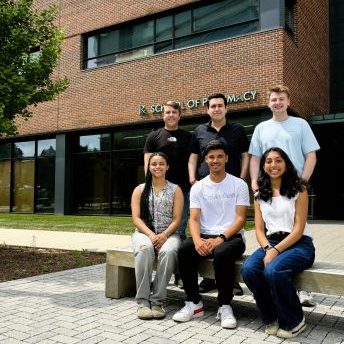
UConn Today: “Six Students Receive Research Awards this Summer in the Sartor Lab”
Kaya Patel, a participant in the UConn PNB Research Experience for Undergraduates program was featured in UConn Today for her summer work in the Sartor Lab.

UConn Today: “Neurobiologists Reveal a Secret of Ondine’s Curse”
Jaseph Soto Perez’ recent publication was featured in UConn Today for contributing to understanding how Phox2b neurons are involved in respiratory control in the brainstem.

Fall 2024 Scholarship Facilitation Fund Award
Dr. Alexander Jackson was awarded the Fall 2024 Scholarship Facilitation Fund Award from the Office of the Vice President for Research for the 2024 Neuroscience at Storrs Symposium.

UConn Today: “Ten Students Earn Awards From Gilman Foundation”
Manogna Reddy is a Physiology and Neurobiology student and Gilman Scholar who will participate in neuroscience research this summer in Salamanca Spain.

2024 CLAS Staff Excellence Award
Penny Dobbins was awarded the UConn CLAS 2024 Staff Excellence Award.


2024 UConn AAUP Excellence Awards
Two PNB faculty members were awarded UConn AAUP 2024 Excellence Awards. John Redden was awarded the Teaching Innovation award. Randall Walikonis was awarded the Service Excellence award.

UConn Today: “Revolutionizing the Cell Mapping Process“
Linnaea Ostroff was featured in UConn Today for her novel cell mapping process, ultraplex microscopy.
Recent Graduates
| Image | Name | Lab | Semester | Program | Current Position |
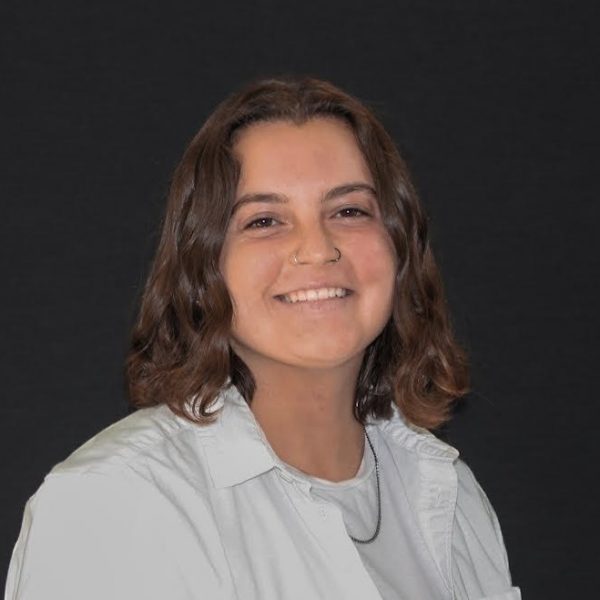 |
Sam Simonovitch | Sun Lab | Summer 2025 | MS | |
 |
Melissa Tran | Zarkada Lab | Summer 2025 | MS | |
 |
Erisa Mullalli | Sun Lab | Spring 2025 | MS | |
 |
Stella Cho | Sun Lab | Spring 2025 | PhD | |
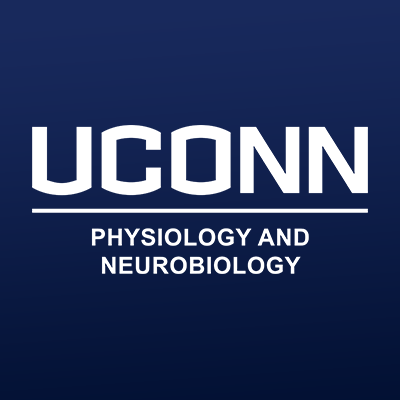 |
Vivian Chow | Sun Lab | Spring 2025 | MS | |
 |
Christopher Engborg | Sciolino Lab | Fall 2024 | MS | PhD student University of Connecticut Physiology & Neurobiology, Rich Lab |
 |
Maggie Khuu | Mulkey Lab/Jackson Lab | Fall 2024 | PhD | |
 |
Yetunde Akinlaja | Nishiyama Lab | Fall 2024 | MS | |
 |
Gianna Raimondi | Ostroff Lab | Summer 2024 | PhD | Field Application Scientist at Agilent Technologies |
 |
Kate Gavilanes | Tanner Lab | Summer 2024 | MS | |
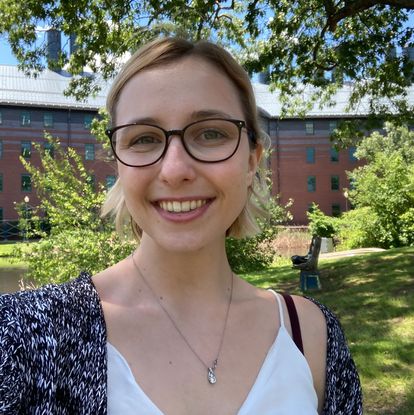 |
Julianna Herman | Conover Lab | Summer 2024 | PhD | |
 |
Brenda Milla | Mulkey Lab | Summer 2024 | PhD | Neurology Postdoctoral Fellow at Beth Israel Deaconess Medical Center, Harvard Medical School |
 |
Jaseph Soto Perez | Mulkey Lab | Spring 2024 | PhD | |
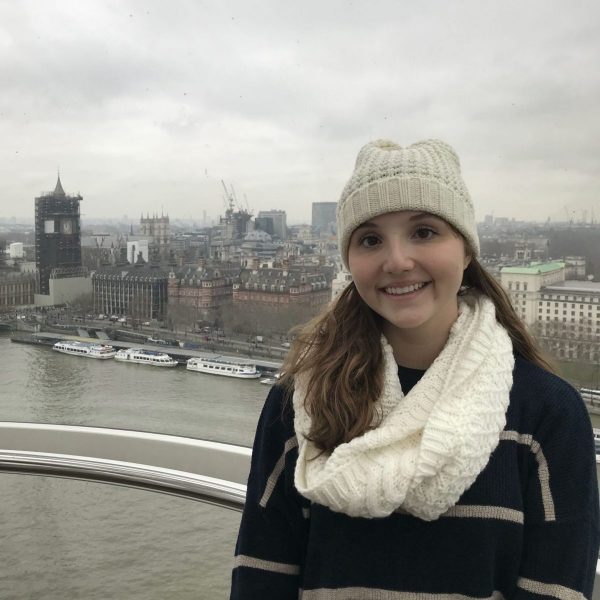 |
Nikki Rittenhouse | Conover Lab | Spring 2024 | MS | Research Technician, Memorial Sloan Kettering Cancer Center |
 |
Jordana Weinberger | Yu Lab | Spring 2024 | MS | Educational Program Assistant 1 Psychology Deparment University of Connecticut. |
 |
Luke Notaro-Roberts | LoTurco Lab | Spring 2024 | MS | Scientist II, Eurofins PSS Insourcing Solutions |
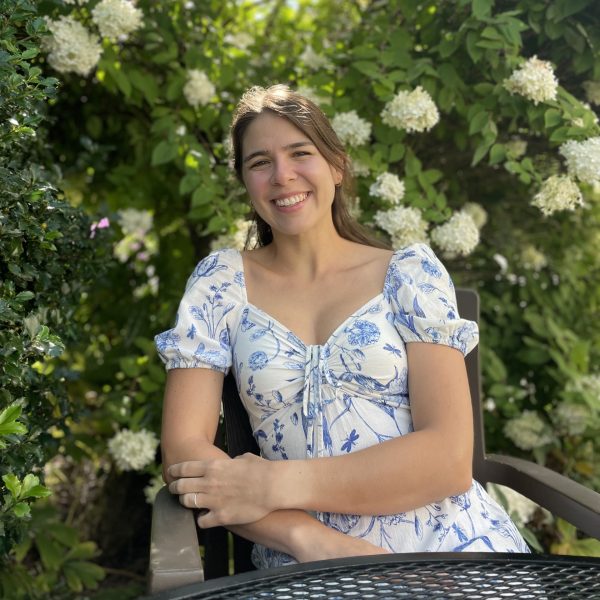 |
Rebecca Oramas | Sun Lab | Spring 2024 | PhD | Postdoctoral Research Associate, Kuan Lab, Brown University. |
 |
Andrew Beard | Sun Lab | Fall 2023 | PhD | Guest Teacher at Charlotte-Mecklenburg Schools |
 |
Morgan Macey | Conover Lab | Summer 2023 | PhD | |
 |
Danielle Caefer | Schwartz Lab | Summer 2023 | PhD | Postdoctoral Research Fellow, Brigham and Women’s Hospital in the Translational Neuroimmunology Research Center, Ann Romney Center for Neurological Diseases, Department of Neurology |
 |
Nissi Varghese | Tzingounis Lab | Summer 2023 | PhD | Associate Scientist, Post Doctoral Fellow, Merck |
 |
Mushirah Majid | Conover Lab | Spring 2023 | MS | |
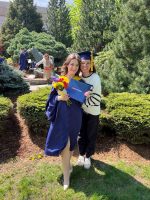 |
Alexandra Porczak | Kanadia Lab | Spring 2023 | MS | PhD student Wesleyan University |
 Recent Publications
Recent Publications
- H- and m-channel overexpression promotes seizure-like events by impairing the ability of inhibitory neurons to process correlated inputs June 30, 2025Channelopathies affecting the hyperpolarization-activated cyclic nucleotide gated (HCN or h-) channel and the Kv7 voltage gated m-type potassium (m-) channel present a paradox in epilepsy research: despite experimental evidence that both over- and underexpression of these channels can be epileptogenic, channel overexpression does not appear to increase the excitatory-inhibitory (E-I) balance as caused by channel […]Scott Rich, Taufik A Valiante, Jérémie Lefebvre
- Morphology of Oligodendroglial Cells June 11, 2025Oligodendrocytes are cells in the central nervous system that are specialised to form myelin sheaths around axons. They are generated from oligodendrocyte precursor cells that persist in the adult brain and are responsible for myelin plasticity that is essential for learning and repair in pathology. Oligodendrocytes exhibit morphological and molecular heterogeneity, and, besides their role […]Arthur Butt, Adam Willis, Rachel Stevens, Ian Hunter, Akiko Nishiyama
- Response to: Anesthetic Effect on the Subthalamic Nucleus in Microelectrode Recording and Local Field Potential of Parkinson's Disease June 4, 2025No abstractCinira Diogo, Christopher R Conner
- An integrated anatomical, functional and evolutionary view of the Drosophila olfactory system May 19, 2025The Drosophila melanogaster olfactory system is one of the most intensively studied parts of the nervous system in any animal. Composed of ~50 independent olfactory neuron classes, with several associated hygrosensory and thermosensory pathways, it has been subject to diverse types of experimental analyses. However, synthesizing the available information is limited by the incomplete data […]Richard Benton, Jérôme Mermet, Andre Jang, Keita Endo, Steeve Cruchet, Karen Menuz
- Parvalbumin-expressing neurons in the ventral medulla are active during wakefulness and promote NREM sleep April 30, 2025A longstanding hypothesis contends that sleep is promoted by sleep-active inhibitory neurons that suppress arousal centers. Sleep may also be facilitated by mechanisms active during wakefulness; however, evidence for wake active sleep promoting neurons is scarce. Here, we use chemogenetics, fiber photometry and circuit mapping to identify subset(s) of inhibitory neurons promote NREM sleep. We […]Colin M Cleary, George M P R Souza, Stephen B G Abbott, Daniel K Mulkey
- Exploring the evolution of evidence synthesis: a bibliometric analysis of umbrella reviews in medicine April 11, 2025CONCLUSION: This bibliometric analysis confirms the expanding influence and utility of umbrella reviews in medical research and decision-making. By charting the evolution and current trends in this field, our study not only showcases the geographical and institutional distribution of research but also guides future scholarly efforts to advance evidence synthesis methodologies.Sandeep Samethadka Nayak, Ehsan Amini-Salehi, Michael T Ulrich, Yasmin Sahli, Micah Fleischman, Masum Patel, Mahdi Naeiji, Hasan Maghsoodifar, Seyed Amir Hossein Sadeghi Douki, Abdolhadi Alotaibi, Niloofar Faraji, Soheil Hassanipour, Mohammad Hashemi, Mohammad-Hossein Keivanlou
- GATA factor Serpent promotes phagocytosis in non-professional phagocytes during Drosophila oogenesis March 26, 2025Clearance of dying cells is essential for tissue homeostasis and requires both professional and non-professional phagocytes; however, it is unclear what promotes phagocytosis by non-professional phagocytes. Follicle cells of Drosophila egg chambers function as non-professional phagocytes to clear large germ cell debris in mid and late oogenesis, providing an excellent model for the study of […]Baosheng Zeng, Haley Grayson, Jianjun Sun
- An integrated anatomical, functional and evolutionary view of the <em>Drosophila</em> olfactory system January 27, 2025The Drosophila melanogaster olfactory system is one of the most intensively studied parts of the nervous system in any animal. Composed of ~60 independent olfactory neuron classes, with several associated hygrosensory and thermosensory pathways, it has been subject to diverse types of experimental analyses. However, synthesizing the available data is limited by the incompleteness and […]Richard Benton, Jérôme Mermet, Andre Jang, Keita Endo, Steeve Cruchet, Karen Menuz
- Multilayer regulation underlies the functional precision and evolvability of the olfactory system January 27, 2025Sensory neurons must be reproducibly specified to permit accurate neural representation of external signals but also able to change during evolution. We studied this paradox in the Drosophila olfactory system by establishing a single-cell transcriptomic atlas of all developing antennal sensory lineages, including latent neural populations that normally undergo programmed cell death (PCD). This atlas […]Jérôme Mermet, Steeve Cruchet, Asfa Sabrin Borbora, Daehan Lee, Phing Chian Chai, Andre Jang, Karen Menuz, Richard Benton
- Efficient gene delivery admitted by small metabolites specifically targeting astrocytes in the mouse brain January 12, 2025The development of efficient and targeted methods for delivering DNA in vivo has long been a major focus of research. In this study, we introduce a gene delivery approach admitted by small metabolites (gDAM) for the efficient and targeted delivery of naked DNA into astrocytes in the adult brains of mice. gDAM uses a straightforward […]Haibin Zhou, Jiajing Dai, Dong Li, Luyao Wang, Meng Ye, Xiaoling Hu, Joseph LoTurco, Ji Hu, Wenzhi Sun
- Plural molecular and cellular mechanisms of pore domain <em>KCNQ2</em> encephalopathy January 6, 2025KCNQ2 variants in children with neurodevelopmental impairment are difficult to assess due to their heterogeneity and unclear pathogenic mechanisms. We describe a child with neonatal-onset epilepsy, developmental impairment of intermediate severity, and KCNQ2 G256W heterozygosity. Analyzing prior KCNQ2 channel cryoelectron microscopy models revealed G256 as a node of an arch-shaped non-covalent bond network linking S5, […]Timothy J Abreo, Emma C Thompson, Anuraag Madabushi, Kristen L Park, Heun Soh, Nissi Varghese, Carlos G Vanoye, Kristen Springer, Jim Johnson, Scotty Sims, Zhigang Ji, Ana G Chavez, Miranda J Jankovic, Bereket Habte, Aamir R Zuberi, Cathleen M Lutz, Zhao Wang, Vaishnav Krishnan, Lisa Dudler, Stephanie Einsele-Scholz, Jeffrey L Noebels, Alfred L George, Atul Maheshwari, Anastasios Tzingounis, Edward C Cooper
- Advancements in Immunity and Dementia Research: Highlights from the 2023 AAIC Advancements: Immunity Conference December 18, 2024The immune system is a key player in the onset and progression of neurodegenerative disorders. While brain resident immune cell-mediated neuroinflammation and peripheral immune cell (eg, T cell) infiltration into the brain have been shown to significantly contribute to Alzheimer's disease (AD) pathology, the nature and extent of immune responses in the brain in the […]Courtney M Kloske, Simin Mahinrad, Christopher J Barnum, Andre F Batista, Elizabeth M Bradshaw, Brittany Butts, Maria C Carrillo, Paramita Chakrabarty, Xiaoying Chen, Suzanne Craft, Sandro Da Mesquita, Luke C Dabin, Davangere Devanand, Violeta Duran-Laforet, Wassim Elyaman, Elizabeth E Evans, Patricia Fitzgerald-Bocarsly, Kate E Foley, Ashley S Harms, Michael T Heneka, Soyon Hong, Yu-Wen A Huang, Stephanie Jackvony, Laijun Lai, Yann Le Guen, Cynthia A Lemere, Shane A Liddelow, Alfonso Martin-Peña, Anna G Orr, Francisco J Quintana, Grace D Ramey, Jessica E Rexach, Stacey J S Rizzo, Claire Sexton, Alice S Tang, Jose G Torrellas, Andy P Tsai, Lynn van Olst, Keenan A Walker, Whitney Wharton, Malú Gámez Tansey, Donna M Wilcock
- Honoring the legacy of Joseph E. LeDoux: introduction to the Special Issue December 14, 2024No abstractDaniela Schiller, Joshua Johansen, Linnaea Ostroff
- CalDAG-GEFI acts as a guanine nucleotide exchange factor for LRRK2 to regulate LRRK2 function and neurodegeneration November 22, 2024Mutations in LRRK2 are the most common genetic cause of Parkinson's disease (PD). LRRK2 protein contains two enzymatic domains: a GTPase (Roc-COR) and a kinase domain. Disease-causing mutations are found in both domains. Now, studies have focused largely on LRRK2 kinase activity, while attention to its GTPase function is limited. LRRK2 is a guanine nucleotide-binding […]Qinfang Liu, Bingxu Huang, Noah Guy Lewis Guiberson, Shifan Chen, Dong Zhu, Gang Ma, Xin-Ming Ma, Jill R Crittenden, Jianzhong Yu, Ann M Graybiel, Ted M Dawson, Valina L Dawson, Yulan Xiong
- Actomyosin contraction in the follicular epithelium provides the major mechanical force for follicle rupture during <em>Drosophila</em> ovulation September 18, 2024Ovulation is critical for sexual reproduction and consists of the process of liberating fertilizable oocytes from their somatic follicle capsules, also known as follicle rupture. The mechanical force for oocyte expulsion is largely unknown in many species. Our previous work demonstrated that Drosophila ovulation, as in mammals, requires the proteolytic degradation of the posterior follicle […]Stella E Cho, Wei Li, Andrew M Beard, Jonathan A Jackson, Risa Kiernan, Kazunori Hoshino, Adam C Martin, Jianjun Sun
Recent Grants

Karen Menuz received an award from the National Institutes of Health for her project, Molecular Basis of Insect Olfaction. Link Here

Anastasios Tzingounis received a Seed Grant from the Institute for the Brain and Cognitive Sciences for his project, KCNQ2 encephalopathy variants lead to global changes to the cortical phosphoproteome. Link Here

Scott Rich received a Seed Grant from the Institute for the Brain and Cognitive Sciences for his project, Deciphering the mechanism of action of Vagus Nerve Stimulation in post-stroke rehabilitation. Link Here

John Redden received two awards from the 2024-2025 Provost’s Common Curriculum Grant Competition.

Natale Sciolino received a NARSAD Young Investigator grant from the Brain and Behavioral Research Foundation for her project, Norepinephrine circuits underlying obesity-induced negative affect.

Cleyton Sobrinho received an award from the Simons Foundation Autism Research Bridge to Independence for his project, Disordered breating in autism: screen for central and peripheral nervous system involvement and therapeutic potential.

Alexander Jackson received a joint award with David Martinelli, UCH, from the National Institute of Neurological Disorders and Stroke (NINDS) for their project, A novel trans-synaptic adhesion complex as a regulator of hypocretin/orexin control of arousal. Link Here

Cleyton Sobrinho received an award from the CCHS Network for his project, Putative roles of NTS neurons in maintenance of breathing and survival in a mouse model of CCHS.

Georgia Zarkada received an award from the Retina Research Foundation for her project, Modulation of retinal vascularization by endothelial cell genetic reprogramming.

Daniel Mulkey received an award from the DHHS/NIH/National Institute of Neurological Disorders and Stroke for his project, Molecular Signature of Parafacial Expiratory Neurons.

Xinnian Chen received an award from the National Science Foundation for her project, A Developmental Model to Understand the Process of Instructor Implementation of Evidence-Based Teaching Practices. Link Here



Andrew Moiseff received an NSF-DUE award as a Co-PI along with Tadarrayl Stark and PI, Daniel Burkey for their project Community, Identity, and Competence: Supporting Low-Income Students in Computing and the Data Sciences at the University of Connecticut. Link Here


Jeffrey Divino and John Redden received the Alan R. Bennett College of Liberal Arts and Sciences Public Health Policy Research Funding award for their project, Integrating Health Policy Into Undergraduate Life Science Curriculum. Link Here

Natale Sciolino received an award from the Brain Research Foundation for her project, Impact of Locus Coeruleus Dynamics on Gustatory Cortex Function. Link Here

Georgia Zarkada received an award from the National Institutes of Health for her project, Targeting TGFB Signaling to Treat Ocular Neovascular Disease. Link Here



Natale Sciolino, Alexander Jackson, and Anastasios Tzingounis received an internal grant from the Uconn College of Liberal Arts and Sciences for shared equipment for their project, Miniature microscopes in behaving rodents for animal vivarium and behavioral spaces. Link Here

Linnaea Ostroff received an award from the National Institutes of Health for her project, New Strategies for molecular cell-type labeling in volume electron microscopy. Link Here

Linnaea Ostroff received an award from the National Institutes of Health for her project, A Versatile Approach for Highly Multiplexed, High Resolution Imaging of Endogenous Molecules. Link Here


Jianjun Sun was a Co-PI on an award for Kazunori Hoshino of Biomedical Engineering for their project, A light-sheet microscopy (LSM)-based, spatially-resolved 3D dynamic mechanical analysis (DMA) instrument for developmental biology and physiology. Link Here


Dr. Joseph Crivello and co-investigator Dr. Karen Menuz were awarded an NSF/BIO/Directorate Biological Sciences award entitled REU Site: Research Experiences in Physiology and Neurobiology at UCONN. Link Here
Recent Awards
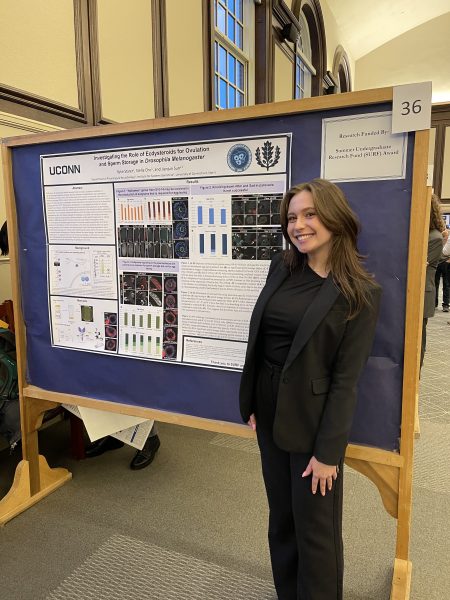
Rylie Starer was awarded the Biology Director’s Award at the All Biology Commencement Reception on 5/3/2025.

Abigail Boria was awarded the Excellence in Systems Genomics Award at the All Biology Commencement Reception on 5/3/2025.

McKenna Rook was awarded the Outstanding Senior in PNB Award at the All Biology Commencement Reception on 5/3/2025.



Abigail Boria from the Kanadia Lab, McKenna Rook from the Menuz Lab, and Rylie Starer from the Sun Lab were chosen among all presenters at the PNB Symposium, 4/25/25, to present at the All Biology Symoposium, 5/2/25.
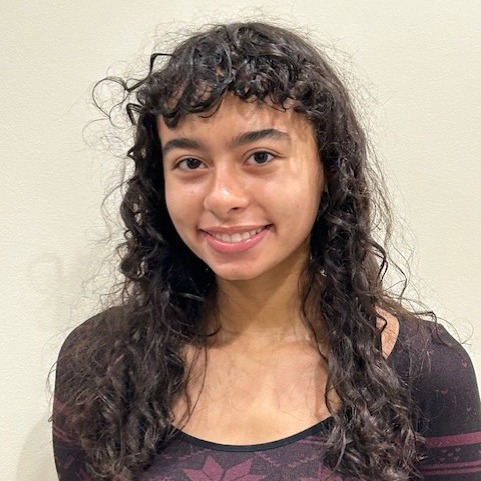
Alexandra Salem was awarded the Summer Undergraduate Research Fund (SURF) Award: Patients with Rett syndrome (RTT) are at increased risk of anesthesia-related complications usually involving respiratory insufficiency or cardiac arrythmia. Preliminary results suggest this phenotype is recapitulated in a mouse model of RTT where delivery of injectable or volatile anesthetic results in cardiorespiratory failure at doses well tolerated in control mice. Based on this, the goals of my SURF project are to determine in RTT mice i) the minimum level of anesthetic needed to induce unconsciousness and ii) test the susceptibility cardiorespiratory failure in this model in response to two commonly used general anesthetic with different putative modes of action.

Michael Jolly, a student in Dr. Daniel Mulkey’s lab was the recipient of an NIH F31 NRSA Fellowship.


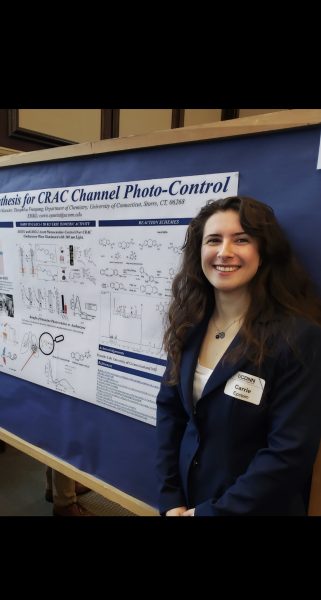
Alana Grant from the Jackson Lab, Akshara Iyer from the Yu Lab, and Carrie Epstein from the Kienzler Lab were chosen among all presenters at the PNB Symposium, 4/22/24, to present at the All Biology Symoposium, 4/26/24.



William Armstrong IV placed 1st, Julianna Herman placed 2nd, and Sydney Ballou placed 3rd in the 2023 Neuroscience at Storrs Symposium poster competition.


Andrew Beard and Danielle Caefer were selected to receive the PNB TA awards for excellence in teaching, 2022-2023.

Yetunde Akinlaja in Dr. Akiko Nishiyama’s lab earned the Kenneth & Paula Munson Family Fund for Student Support in Health Sciences Fellowship (ISG).

Monica Strain, a student in Dr. Daniel Mulkey’s lab was the recipient of an NIH F31 NRSA Fellowship.

Eugene Kim, an undergraduate student in Anastasios Tzingounis’ lab and William Armstrong IV, a graduate student in Alexander Jackson’s lab won the Nu Rho Psi Poster Award for Scientific Merit at the NEURON conference in April, 2023.
Recent Conferences

Alexander Jackson organized the 27th Annual Neuroscience at Storrs Meeting in the Dodd Center/Bousfield Building on the Storrs Campus, Oct 22, 2024. Link Here

Alexander Jackson is serving as a Co Chair and co-organizer of the 2024 Gordon Research Conference (GRC) on the Hypothalamus at Bates College in Maine. Link Here

Geoffrey Tanner co-organized the 2024 Neuron Conference April 21 at the Frank H. Netter MD School of Medicine at Quinnipiac University. Link Here

Alexander Jackson was the Co-Vice Chair for the 2022 Inaugural Gordon Research Conference on Hypothalamus in Ventura, CA. Link Here
Events
- The start of semester Annual PNB Meeting and Field Day will take place on August 22, 2025. The location is TBD.
- The All Biology Symposium took place on May 2, 2025. Winners from the departmental symposiums competed for a chance to win biology wide awards, including the Ertman Award.
- The PNB Symposium took place on April 25, 2025 in PBB 131. Graduating PNB seniors gave an oral presentation, and the top three winners moved on to the All Biology Symposium.
- PNB students had the opportunity to participate in the Frontiers in Undergraduate Research Exhibitions in April of 2025 to present their undergraduate research.
- PNB hosted its semi-annual UConn PNB Lounge & Learn: Student Faculty Mixer on November 21, 2024 in BPB 130. Undergraduate students had the opportunity to learn about what research is available within PNB for undergraduate students and what it is like to work in a research lab.
- The virtual Graduate Student Recruitment Open House took place on November 15, 2024. A Zoom link was emailed to all RSVPs.
- The in-person Graduate Student Recruitment Open House took place on November 8, 2024 in GW001.
- The 27th Annual Neuroscience at Storrs Conference took place October 22, 2024 in the Dodd and Bousfield buildings.
- The Department Retreat took place on August 21, 2024 at The Branford House at the UConn Avery Point campus.